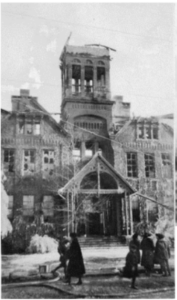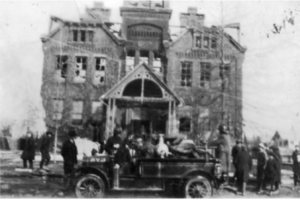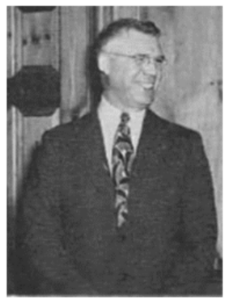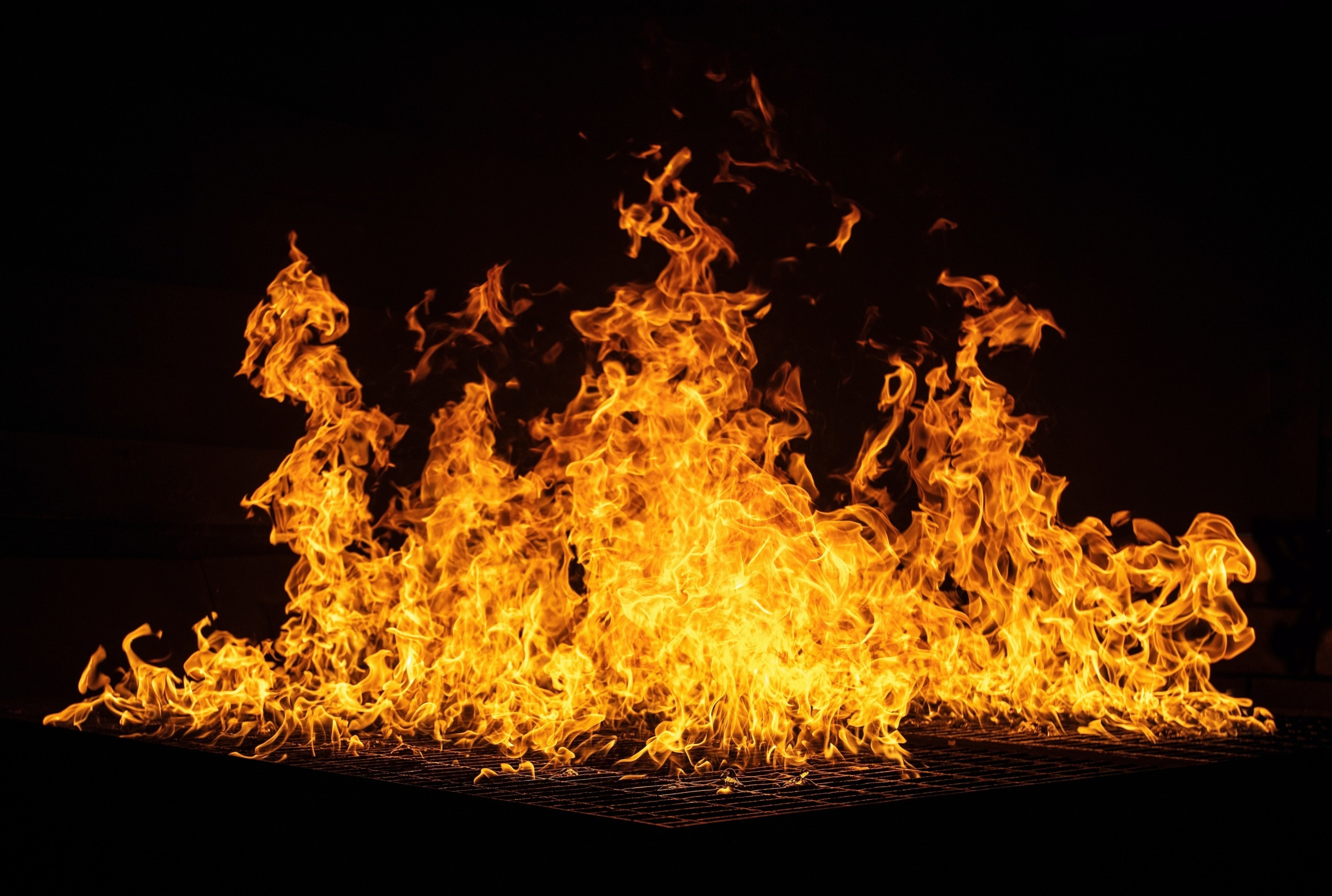 by David Wright
by David Wright
Historian
Stratford Historical Society
Stratford High School, aka Center/Consolidated School, after the fire on February 19th, 1921. Likely the biggest news story of 1921 was the burning of the Stratford High School, today termed the “Center School Fire,” on February 19th . Both high school and grammar school students met in the building at the time of the blaze.
The initial cause of the blaze was said to be arson, but, to the best of our knowledge, the perpetrator of the blaze was never identified, and the official cause of the fire was never conclusively determined. Town historians William Howard Wilcoxson and Lew Knapp were silent on the cause of this blaze. Arson seems likely as matches were found throughout the building, and the fire began early on a Saturday morning. It’s as if the arsonist wanted to ensure no one would be injured by the blaze, and that the blaze would burn as long as possible undetected.
The damages from the fire were said to be $200,000. The town had only $33,000 in insurance coverage for the building. Following the blaze a terrible blizzard struck Stratford crippling traffic throughout the town.
High School boys were asked to assist in removing supplies from the school for relocation to other buildings in town. Students at the school were “distributed” to various churches and buildings nearby. Classes restarted on February 23rd. The high school students were without a school building to meet in until the “new” high school opened in 1925. Basketball games were played at the Town Hall.
 The lives of teachers, students, parents of students, administrators, and many other townspeople were, of course, disrupted by this fire. However, we chose to look at five residents whose lives were directly impacted by this:
The lives of teachers, students, parents of students, administrators, and many other townspeople were, of course, disrupted by this fire. However, we chose to look at five residents whose lives were directly impacted by this:
Southern New England Telephone operator, Marie Blucher, was on duty at the SNET central office which was located at 2362 Main Street. (The building has been converted to apartments at this time). Marie immigrated to Stratford with her parents from Denmark in 1899 when Marie was a newborn baby. Her family resided at 311 King Street which today is the site of the new Stratford High School.
Apparently, night patrolman David Dinan called in a general alarm which was picked up by Miss Blucher. Working alone on the graveyard shift, Miss Blucher began to telephone firemen one by one. Even though she could see the fire burning from the school building adjacent to the SNET building, she stayed on the phones directing phone calls as needed. She surely knew that a renegade burst of flames from the school building could engulf the SNET building endangering her ability to safely exit the facility.
Marie placed a call for mutual aid to the Bridgeport Fire Department. Bridgeport responded with a large pumping truck and aided greatly in fighting the blaze. Sleeping just several yards away at his mother’s home on Warwick Avenue, twenty- eight year old Harry Flood responded to the alarm. Harry had recently returned from military service in World War I in July 1919. Upon returning home, Harry was selected to be the Assistant Fire Chief for a time.

Harry Flood, who lived nearby at his mother’s home at 48 Warwick Avenue, was, undoubtedly one of the first fireman on the scene. When Harry, and other firefighters, arrived on the scene, they found the fire appeared to be confined to a small lunch room next to the boiler room near the front of the building. With a bit of firefighting effort, it appeared that the fire had been brought under control. Moments later, however, flames burst through the roof.
When the roof caved in, five firemen sustained injuries including Harry Flood who suffered from smoke inhalation. It took the firefighters until 5:30 a.m. to finally contain the blaze.
The doctor who treated Harry told Harry the damage done to his lungs was sufficient that he would be unable to continue playing basketball for the Stratford American Legion basketball team. This must have been devastating news to both Harry and his teammates as Harry was a star player on the team.
Harry would recover from his injuries and go on to become Stratford’s longest serving town manager. Harry served as Town Manager from 1945 until 1963. Serving through several rotations of political intrigue and machination, Harry’s career as Town Manager was judged by most residents to have been a great success. Harry passed away in 1966 at the age of 73. Surely, the memories of the high school stayed with him throughout his life.
Nettie Filmer was a member of the School Board and would have heard the commotion of the firefighters, and seen the flames at the high school, from her home at 797 East Broadway. Nettie was a member of, and leader in, Stratford’s Equal Suffrage Association. Connecticut had granted the right to women to vote in local town elections in 1893. Women were also granted the right to serve on local town boards at the same time. Nettie, along with Nettie’s next door neighbor, Alice Judson, were two of the first women elected to a town office.
The burning of the high school building created a need for someone to step up and create a plan for either rebuilding the incinerated high school or building a new high school at another location. Nettie was charged by the school board with creating such a plan. Nettie attended the groundbreaking for the new high school on North Parade in 1924. She also worked to have the burned high school rebuilt as a grammar school which was renamed as Center School. Nettie passed away in 1936 at the age of 65. She was able to see the fulfillment of her leadership in the construction of Stratford High School which opened in 1925.
Perhaps one of the lives most disrupted by the Stratford High fire was that of Assistant Fire Chief Frederick Palmer. Frederick Palmer had succeeded Harry Flood as Assistant Chief. Mr. Palmer was born in 1881 and resided with his family on Broadbridge Avenue.
In an effort to affix blame for the fire, and the town’s lack of adequate insurance coverage for the high school, a scapegoat needed to be found. Unfortunately for Mr. Palmer, Fire Chief Alan Judson was very popular and well-connected, so he would never do as a sacrificial lamb. The unsolicited sacrifice, apparently, fell to Assistant Fire Chief Palmer.
Mr. Palmer’s resignation was asked for. Whether Mr. Palmer submitted his resignation at that time, or subsequently, we can’t be sure. What we do know is that Mr. Palmer was serving as a Fire Lieutenant in 1927, and was working for the railroad in 1930. Mr. Palmer’s career seems to have been reduced to ashes alongside the high school.
One Stratford High School student was slumbering in bed in her parent’s home at 1566 Stratford Avenue. Her father, was a well-known mechanic and dairyman in town. Perhaps because of his dairyman responsibilities he was up before dawn on the morning of February 19th. We can’t know for certain how Susan Freeman learned of the burning of her high school, but she would surely have known early that Saturday morning of the 19th .
Susan completed her high school studies in June of 1921 having no school building in which to conclude her Stratford school career. Susan’s life, while impacted at the time, appears not to have been materially altered by the burning of her school. From the time she was a very young girl, she’d wanted to grow up to become a nurse. Susan was ill much of her senior high school year suffering from a bad case of diphtheria.
Following her graduation from the Stratford school system she entered the nursing school at Freedman’s Hospital Training School for Nurses in Washington DC in 1923. Susan completed graduate courses in nursing at Howard and Catholic universities and at Columbia University.
As World War II approached, Susan joined other black nurses who signed on for service with the Red Cross. Later, during World War II, the nurses were recruited into the Army Nurses Corps.
Susan headed up the very first Army unit of black nurses. She received many commendations for her service to our country. Susan was active in her Stratford Baptist Church and in her town. Susan’s life was profiled in the book Profiles of Negro Womanhood (1966) as well as African American Connecticut EXPLORED (2013).
The Bridgeport Post profiled Susan’s life for Black History Month in 1974. (You may read this entire article on the Stratford Historical Society newsletter website at www.stratfordhistoricalsociety.info). Susan lived in her parent’s home on Stratford Avenue until her death in 1979.
One fire: five impacted and impactful lives. One hundred years after the Stratford High School fire of 1921, a new Stratford High stands on North Parade. Stratford High School, rebuilt as Center School, has seen a “new” Center School come and go. The Center School building now serves as the offices of the Stratford Board of Education. Proposals have been advanced to the town to convert the old Center School to
apartments.
One can’t help but wonder what changes there might be in our town, today, had Stratford High not burned on February 19 th , 1921. How different would Marie’s, Harry’s, Nettie’s, Frederick’s and Susan’s life have been had there been no morning Stratford High fire in 1921? How different would our lives have been?



